Jiecang Electric Standing Desk Base Review (UpLift Desk Version)
- Lab tested
Like most reviews sites, our editorial staff and laboratory testing expenses are partially offset by earning small commissions (at no cost to you) when you purchase something through those links. Learn More

Overview
| Review Summary |
The Jeicang is a good middling option for those who want a little better reliability and durability than the bottom end desks like Autonomous and IKEA. We narrow our recommendation, however, to middle range usage. That is, for the not too tall user, not too wide a desktop, and not too heavy a desktop load. |
|---|---|
| MSRP / List Price | $489 |
| Street Price |
UpLift V2 frame: $489 |
| Warranty |
7 Year All-Inclusive |
| Lift Type |
Electric |
| Transit Speed |
1.3″ per sec. |
| Colors Available |
Black |
| Construction |
Aluminum |
| Adjustment Range |
Height range: 24.5″-50.25″ |
| Weight Capacity |
355 lbs. |
| Dimensions |
42.25″ – 70″ W |
| Noise Level |
50 dB |
| Typical Assembly Time |
45 to 90 minutes |
| ANSI/BIFMA Certified |
No |
| NEAT™ Certified by Mayo Clinic |
No |
| Competition | DIY Standing Desk Base Frames Round-Up Review |
| User Reviews | Amazon |
| Where to buy |
Buy on Amazon |
Rating
| Stability | |
|---|---|
| Reliability | |
| Customer Experience | |
| Quality and Aesthetics | |
| Value | |
| Positives | Middle-of-the-road transit speed of 1.3 inches per second, height range of 27", and decent quality components; full digital hand controller with four programmable height settings |
| Negatives | Does not hold up to 355 lb. weight specification, motors overheated during our testing before the published duty cycle was reached |
Bottom Line
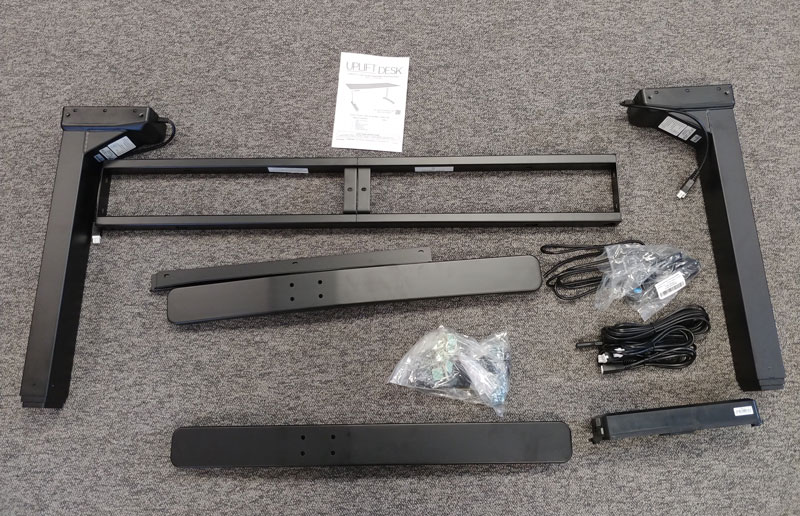
If you’re thinking about putting your standing desk together DIY style, then you’ve got a lot of choices in standalone bases that you can buy to match up with a desktop. The Jiecang Linear Motion Technology Company of Zhiejang, China, is one of the long-time producers of electric standing desk bases, used more than any other base by popular online sellers of standing desks, including GeekDesk, S2S (sold by Ergoprise), Jarvis (sold by Fully) and UpLift (sold by TheHumanSolution) to name but a few.
There are now dozens of manufacturers of standing desk bases in China but Jiecang is still king of the hill in moving commodity volumes through US OEM resellers (OEM = Original Equipment Manufacturer, meaning the entire base is supplied to the reseller as a finished product, from the Chinese factory in this case). To our knowledge, all of Jiecang’s prominent US resellers bundle the base with a variety of house brand tabletops (some made in China, some made in the US) to create full desk products, but they also sell the base standalone for those who have an existing top they want to use, or have something more exotic or homemade in mind. Hence the Jiecang base finds its way into a lot of DIY standing desks.
Over the years, we’ve tested a number of desks that were built on Jiecang bases. In addition, the engineers at our sister company, iMovR, have evaluated them extensively for potential use in their own products, so our review staff has had a lot of interaction with these bases and with the Jiecang factory representatives. (iMovR has since moved away from all Chinese suppliers and now offers only American made desks). To be sure, we have heard from some of Jiecang’s OEM resellers that reliability issues that plagued earlier generations of Jiecang desks have significantly improved over time. That’s the good news. The bad news is that stiff competition from dozens of copycat vendors in China has placed extreme pressure on Jiecang to cut their own costs in order to remain competitive.
What China is Really Good At
When we talk to base manufacturers in Chinese versus US and European companies, there’s a distinct difference in their view of what “innovation” means. To be very blunt about it, the Chinese factories tend to view innovation as a “race to the bottom,” finding cheaper and cheaper ways of making the same product, whereas the American and European companies tend focus their engineers on making their newer products perform better than earlier generations, and last longer.
The European and American engineers have contributed advances like precision laser cutting, exotic alloys for making the linear actuator mechanisms move smoothly against each other, and better anti-collision sensors. The Chinese engineers have mostly contributed production efficiencies by finding ways to use cheaper parts components and removing frills that customers often don’t even know they’re paying for. They’re also a lot less focused on things like durability, stability, and ergonomics, especially where there might be patents blocking their way. Jiecang, like most of its Chinese factory peers, is not an exception to the rule.
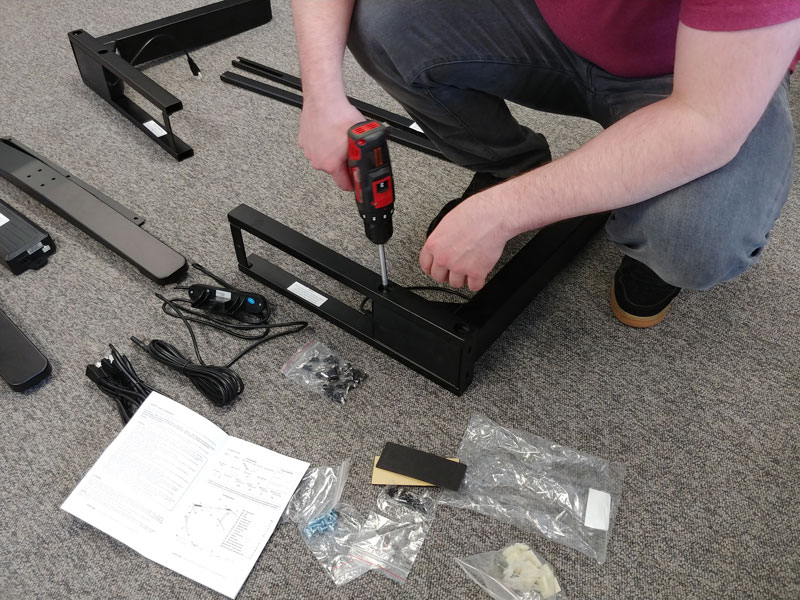
In contrast to American or European-made, and even Taiwanese-made bases, the Chinese brands will tend to be manufactured to looser precision tolerances and use less steel. This makes them cheaper to produce and lighter to ship but results in shakier desks that wear down their “glide” components faster (the all-important gaskets that separate the telescoping leg segments). They’re simply not going to live as long or operate as reliably as American or Taiwanese-made, and that is also reflected in their shorter warranties. Every once in a while we purchase a new Jiecang base from one of its US resellers to see how the platform has evolved; in this case, we lab tested the newest version of the UpLift base sold by TheHumanSolution.
Variations on the Theme
It’s important to note that not all Jiecang bases are created equal. Since their OEM customers are all fierce competitors of each other, Jiecang explicitly requires them to pay for new tooling so that each has its own ever-so-slightly distinguishing aesthetic features from the rest of the pack. They focus on the most visible components, namely the feet and the hand controllers. For the general public, these are going to be the most obvious visual cues to tell a Jarvis desk apart from an UpLift desk. But the linear actuators, a.k.a. the “lifting columns,” as well as the power supply, crossbars and top support arms that constitute the rest of the frameset are less likely to have costly variations; they are generally kitted from the same off-the-shelf parts as their competitors are using in their desk systems.

Other differentiating points might include paint color options and the warranty period offered. The warranty offered by Jiecang to its OEM resellers is likely much shorter than what some of them offer to their direct customers, as everyone’s jockeying for a little differentiation.
While some of the Chinese-made competitors like UpLift and Fully have upped their warranty terms to seemingly match standout warranties like iMovR’s, consumers should be aware that not all warranties are created equal. Some insert a bevy of carve-outs in the fine print that might leave you out in the cold if ever you run into a component failure in the future. In fact, there’s so much spin going on in warranty terms marketing claims these days that we had to write a separate primer just on How To Compare Warranty Policies Between Standing Desk Manufacturers, which we encourage the consumer to read ahead of making their final purchase decision.
Our staff experts’ advice is to always go with the higher-quality componentry of a top-shelf American or European-made base and significantly reduce the odds of ever having to deal with the immense hassle of an out-of-commission desk. Keep in mind that desks generally start to underperform before they fail, and loose manufacturing tolerances will lead to performance issues such as grease streaking, squeaking when in transit, and increasing shakiness over time.
Middling Quality Tier
While Jiecang bases are a commodity product they’re not the lowest tier when it comes to quality. That crown goes to the likes of Autonomous, StandSteady, Massport and the IKEA Bekant (made in Lithuania), where you can find the most minimal desk for $300, and expect to get what you pay for (i.e. reliability and durability shortcomings). Jiecang is definitely in the tier above, but their product quality doesn’t quite reach the level of other Chinese manufacturers like Kaidi or SPFE. Unfortunately, these premium brands are generally available only to OEMs, not to end consumers, so they aren’t an available DIY option.
See our Buyer’s Guide to American-Made Standing Desks for more details on these differences.
The Good
The Uplift standing desk base has features appropriate to its price tier, with a middling transit speed of 1.3 inches per second (on a spectrum of older Jiecang models that run 1.1 ips, up to the Lander and Lander Lite bases at 1.6 ips), a stated lift capacity of 355 lbs (on a spectrum of 150 for the Bekant to 360 lbs for the Lander), and with a full digital hand controller with four programmable height settings, albeit of a somewhat cheesy look and feel. It is also in the middling range in terms of noise signature although noise increases and the transit speed slows down as the load is increased. The height range is middling as well, going from 23.x inches to 50.8 inches. Unlike some American bases, there is no option to add leg extenders to reach up to 55″, so if you’re particularly tall or plan to use an under-desk office treadmill (or both) none of the Jiecang models will reach the required height.
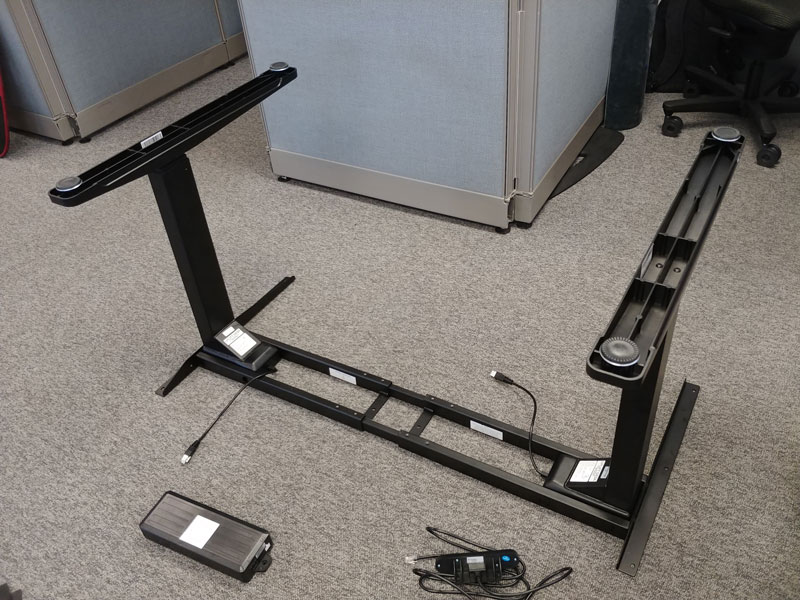
As we said, Jiecang has been making continuous improvements in what used to be a shoddy field failure ratio according to reports we’ve received from their OEM customers. And this is reflected in the increasingly longer warranty that UpLift desk has offered to its customers over the past few years. UpLift now provides a 15-year warranty on both frame and desktop, it’s not without several asterisks. The warranty exclusions include normal wear and tear over time, hairline cracking due to changes in temperature and humidity, and changes in surface finish due to aging or exposure to sunlight. The warranty is reduced for anything beyond 8 hours of use per day and 40 hours of use per week. It’s also excluded if the assembly is improper, which is especially problematic on a difficult assembly like this desk.

Essentially this 15-year warranty on the desktop can be explained away for many different reasons. For more information on warranties, be sure to read our primer on How to Compare Warranties on Standing Desks.
The UpLift base is also sold in a 3-leg configuration if you want an L-desk. The 3-leg version comes with a listed weight capacity of 535 lbs and is a solid deal at $659.
The Bad
The process of assembling the UpLift is fairly standard in terms of the amount of time required, difficulty and number of parts when compared to most all Chinese-made bases in this price tier. Like its minimalist componentry, the instruction manual is printed in a very small font in a small format and is somewhat hard to follow, saving a few cents in paper cost, but hopefully, you’ll only have to reference it this one time to build your base. Fixing points for the desktop (i.e. the screw holes) are surprisingly few – only eight in total, and only two of those for the entire span of the crossbars. So if you’re planning on a wider desk, which will already be inherently less stable than a narrower desk, the lumber’s stiffness will not add much to the stability of the frame unless it’s very thick. Most telescoping-width base designs have at least 16 fixing points, which helps a lot with the stability of the desk.
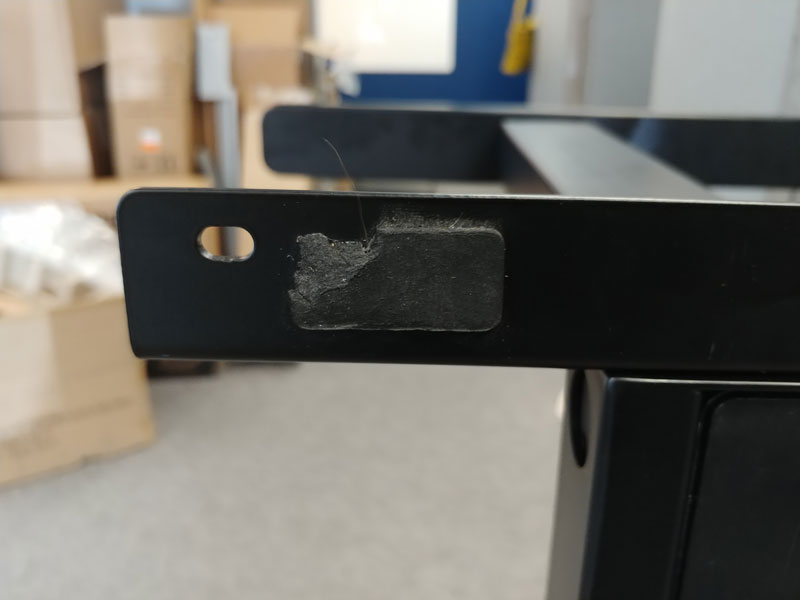
Exacerbating the small number of fixing points is the use of three thin, crumbly pieces of foam on each top support arm, placed there to dampen vibrations from the linear actuators from being transmitted through the desktop. This is something else we haven’t seen before on any other base (though some higher-quality Chinese base makers use compressible rubber washers at every screw hole for the same effect). The concern with these is that they aren’t also included along the crossbars, so if you tighten down the desktop fixing screws firmly (as you should) you’ll get a very slight bow in the middle of the desk.
The molded aluminum feet are quite strong in their internal structure even though they ping like a tin can when you tap them with your fingertip. Compared to the feet of most every other desk we’ve ever tested they are by far the lightest. Sure, it helps keep cost down to use less material and to ship a lighter box, but a steep price is paid in stability. With a typically-sized desktop attached to the UpLift desk base, the rocking motions are pronounced when you get into the standing height range. Longitudinally (front to back) the desk becomes quite “tippy” above about 40″ of height. Heavier feet make a huge difference, lowering the center of gravity of the desk. This is one point that UpLift’s most direct head-to-head competitor, Fully, makes about their Jarvis desk, which employs much heavier feet.
The UpLift base doesn’t have the greatest telescoping range for the frame width. We tried taking it to the max width that is published in the manual, putting 33″ of spread between the left and right crossbar tubes, but the only way to do that is to have only one set screw holding the center rail on each end. For both set screws to secure the rails in place we could get only 31″ of spread. At this setting, we measured 65″ of available space between the feet. The seller claims this base can be used with tabletops as wide as 96″ but we seriously question the practicality of doing so given the trippiness of the frame at standing heights.
One feature that residential customers might like on the UpLift is that the user can reprogram the desk to “one-touch” mode versus the default “constant-touch” mode. Constant mode is a requirement for UL Certification in the USA, meaning the user’s finger has to remain on the button the entire time the desk is rising or descending, for safety reasons – even if the desk has an anti-collision feature (which the UpLift base does). In China, they don’t have this safety rule, so UpLift has chosen to give its customers the choice of switching the desk to one-touch with a few easy steps. The only problem with that is that most corporate, government and education customers have strict rules against buying products that don’t have UL certification, to reduce their own liability exposure should an employee be injured. The reason we list this under The Bad and not the The Good is that UpLift/Jiecang do not disclose that changing this setting would violate the conditions of UL approval in the United States. (The only desk on the market that has one-touch and is UL Certified is the Lander, which is sold by our sister company iMovR, and has an accompanying smartphone app with a “clickwrap liability waiver” that allows the user to switch the desk to one-touch without violating the certification.)
Because assembling the UpLift V2 base can be difficult, adding an extra leg adds a fair amount of time to the task. The support brackets to attach the two desktops are also quite small when compared to competitors’ L-shaped DIY bases like iMovR’s.
The Ugly
Jiecang (and it’s OEM resellers) have had a long history of exaggerating their performance specs. Yes, the UpLift base will haul at 1.3 inches per second, but not loaded at its 355 lb published max weight specification. In fact, we couldn’t get the desk to even reach its top height before the motors overheated and the controller went into error mode; and that was at a transit speed 25% slower than the spec rating. While the published specification for duty cycle is 2 minutes of operation with 18 minutes of rest for motor cool-down we started noticing very unusual motor behavior after only two up/down cycles (about 80 seconds) with only a 300-lb load, something we’ve never seen any other desk do in the lab.
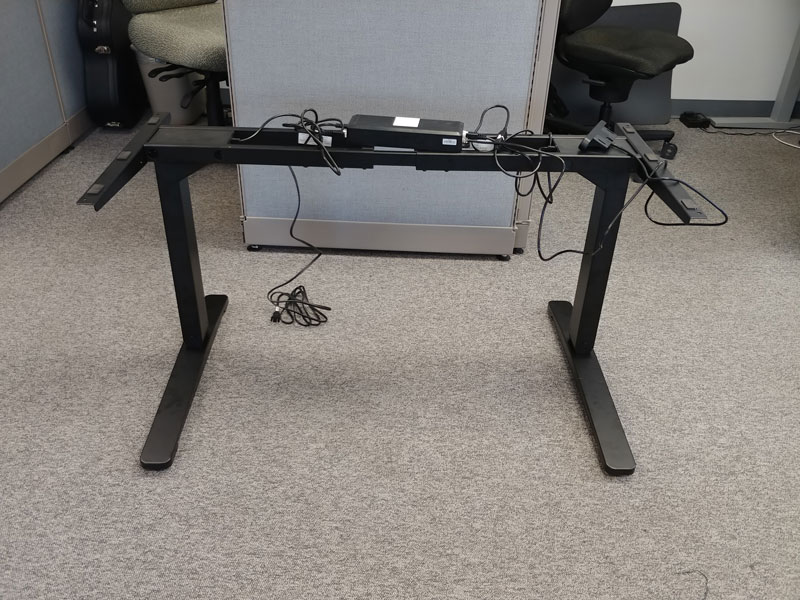
Rather than the smooth, consistent up-down movement we got in the first two cycles, we observed jittery disruptions, in both upward and downward motion, and bouts of sluggishness and noisiness. By the end of the two-minute duty cycle, we were smelling the burning insulation from the motors. While the controller is supposed to sense current overloads and automatically stop the motor Jiecang seems to set the threshold too high, risking permanent and progressive damage to the motors. This was the first time we’ve seen the motors on an electric standing desk overheat before the published duty cycle limit was reached or before the built-in, current-sensing safety switch turned off the power. That smell from the motors is insulation burning off the wires in its electromagnetic coils. If overheating occurs often enough the wires will eventually short, which is the most common way an electric motor “dies.”
Why we test to the limits
A typical standing desk base is going to endure at least a couple of cycles a day of use, and like any mechanical thing – a car or an airplane – with each cycle a few more molecules wear off the components. In the case of linear actuators, the manufacturing tolerances of the telescoping tubes and the “glides” that separate them are hypercritical, measured to the micron. Too loose and your desk will wobble too much (too much “deflection,” in linear actuator parlance); too tight and your motors will work too hard to overcome friction (too little deflection). Just as you wouldn’t want to get on an airplane that the FAA hasn’t tested all the way to the manufacturer’s specification limits, buying a desk without knowing how it will perform under its own published limits is trusting that company’s marketing copy over real-world, independent testing.
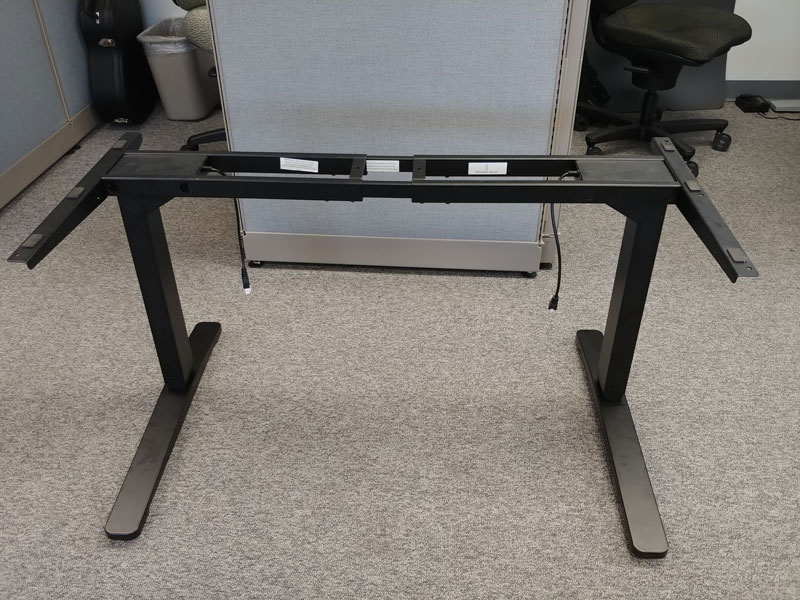
While you may never use the desk with 355 lbs on it or cycle it up/down more than twice in a row, it’s only at these margins that we can truly compare the quality of one desk over another. Otherwise, they all perform pretty well in narrow configurations under low loads… until the day they don’t. Failure may not manifest as an outright motor failure but rather as an insidious degradation in stability, the development of a pronounced squeaking when lifting or descending, or the desk just getting very noisy.
The better a desk performs at full testing loads the more assurance the consumer can have that it will not fail prematurely. A failed lifting column is a royal pain. It’s such a huge hassle to disassemble the desk, order a replacement part, ship the bad part back, and rebuild the desk that many consumers wouldn’t bother; they’d just junk it and buy a better one next time.
Another important aspect of limits testing is to see how the base recovers from a failure mode. Although we do not intentionally exceed the published specifications of the product (we presume the manufacturer has done this and has established the appropriate limits for marketing claims) sometimes the product doesn’t meet its own published limits, as was clearly the case with the UpLift three-segment standing desk base. So we got to see how the user would recover from a number of different error codes. We never experienced an overheat error code (HO1 according to the manual). There is no explanation of the error codes in the manual, just a reset procedure. And that reset procedure is more onerous than any we’ve ever seen on any other electric standing desk. On the third try, we got the reset to finally “take,” but we’re not sure consumers who don’t do this for a living would have the same degree of patience before giving up and sending the base back.
The Bottom Line
The Jeicang is a good middling option for those who want a little better reliability and durability than the bottom end desks like Autonomous and IKEA, but can’t spring the extra $100-$200 for something American made. We narrow our recommendation, however, to middle range usage. That is, for the not too tall user, not too wide a desktop, and not too heavy a desktop load. If you’ve decided that a Jiecang base is right for you, then it comes down to choosing which OEM reseller’s version is best. Since stability is such an important factor the consumer’s best clue might just be to ask the vendor how much their desk’s feet weigh, and anything else they’re willing to share about how their desk might be different from their competitors’. Be sure to compare the UpLift to the Jarvis, at the very least. You’ll generally find them at the same price. Buy the UpLift or Jarvis through Amazon for the extra consumer protection—in case you receive it, and don’t love it.

0 Comments
Leave a response >